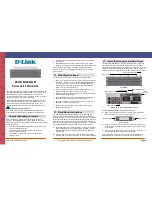
75
Glossary
Device driver: Software that controls how a computer communicates with a device, such as a printer or mouse.
Digital Cross-connect System (DCS): The CO device which splits and redistributes the T1 bandwidth. The DCS takes time slots from
various T1 lines and alters them to provide the needed connectivity. DCS connections are made with software at an administrator's
workstation.
Digital Data: Information represented by discrete values or conditions (contrast "Analog Data").
Digital Loopback: A technique used for testing the circuitry of a communications device. Can be initiated locally, or remotely (via a
telecommunications device). The tested device decodes and encodes a received test message, then echoes the message back. The
results are compared with the original message to determine if corruption occurred en route.
Digital PBX: A Private Branch Exchange that operates internally on digital signals. See also "Exchange".
Digital Service, level 0 (DS0): The worldwide standard speed (64K bps) for digital voice conversation using PCM (pulse coded
modulation).
Digital Service, level 1 (DS1): The 1.544M bps voice standard (derived from an older Bell System standard) for digitized voice
transmission in North America. The 1.544M bps consists of 24 digitally-encoded 64K bps voice channels (north America) and 2.048M
bps (30 channels) elsewhere.
Digital Signal: A discrete or discontinuous signal (e.g., a sequence of voltage pulses). Digital devices, such as terminals and comput-
ers, transmit data as a series of electrical pulses which have discrete jumps rather than gradual changes.
Digital Signaling Rates (DSn): A hierarchical system for transmission rates, where "DS0" is 64K bps (equivalent to ISDN B channel),
and DS1 is 1.5 Mbps (equivalent to ISDN PRI).
Digital Transmission: A method of electronic information transmission common between computers and other digital devices. Analog
signals are waveforms: a combination of many possible voltages. A computer's digital signal may be only "high" or "low" at any given
time. Therefore, digital signals may be "cleaned up" (noise and distortion removed) and amplified during transmission.
Digitize: To convert an analog signal to a digital signal.
DIP switch (pronounced "dip switch"): A set of tiny toggle switches, built into a DIP (dual in-line package), used for setting
configurable parameters on a PCB (printed circuit board).
Driver: A software module that interfaces between the Operating System and a specific hardware device (i.e. color monitors, printers,
hard disks, etc.). Also known as a device driver.
Drop and Insert: The process where a portion of information carried in a transmission system is demodulated ("Dropped") at an
intermediate point and different information is included ("Inserted") for subsequent transmission.
DTE (Data Terminating Equipment): A term used to include any device in a network which generates, stores or displays user
information. DTE is a telecommunications term which usually refers to PCs, terminals, printers, etc.
DTMF (Dual-Tone MultiFrequency): A generic push-button concept made popular by AT&T TouchTone.
E
E&M: A telephony trunking system used for either switch-to-switch, or switch-to-network, or computer/telephone system-to-switch
connection.
EIA: The Electronics Industries Association is a trade organization in Washington, DC that sets standard for use of its member
companies. (See RS-232, RS-422, RS530.)
Encapsulation: A technique used by network-layer protocols in which a layer adds header information to the protocol data unit from the
preceding layer. Also used in "enveloping" one protocol inside another for transmission. For example, IP inside IPX.
Errored Seconds (ES): Any second of operation that all 1.544M bits are not received exactly as transmitted. Contrast "Error Free
Seconds".
Error Free Seconds (EFS): Any second of operation that all 1.544M bits are received exactly as transmitted. Contrast "Errored
Seconds".
ESF Error Event: A T1 error condition that is logged when a CRC-6 error or an OOF error occurs.
Ethernet: A 10-megabit baseband local area network that enables multiple stations to access the transmission medium at will without
prior coordination, avoids contention by using carrier sense and deference, and resolves contention by using collision detection and
transmission. Ethernet uses carrier sense multiple access with collision detection (CSMA/CD).
Excess Zeros: A T1 error condition that is logged when more than 15 consecutive 0s or less than one 1 bit in 16 bits occurs.
Exchange: A unit (public or private) that can consist of one or more central offices established to serve a specified area. An exchange
typically has a single rate of charges (tariffs) that has previously been approved by a regulatory group.
Exchange Area: A geographical area with a single uniform set of charges (tariffs), approved by a regulatory group, for telephone
services. Calls between any two points within an exchange area are local calls. See also "Digital PBX", "PBX".
Содержание MultiFRAD 200 Series
Страница 1: ...Router Two Port Frame Relay Access Device MultiFRAD 200 Series Model FR2201 User Guide...
Страница 5: ...Router Two Port Frame Relay Access Device Chapter 1 Introduction and Description...
Страница 12: ...12 MultiFRAD II User Guide...
Страница 13: ...Router Two Port Frame Relay Access Device Chapter 2 Installation...
Страница 16: ...16 MultiFRAD II User Guide...
Страница 17: ...Router Two Port Frame Relay Access Device Chapter 3 Software Loading and Configuration...
Страница 25: ...Router Two Port Frame Relay Access Device Chapter 4 MultiFRAD Software...
Страница 47: ...Router Two Port Frame Relay Access Device Chapter 5 Remote Configuration and Management...
Страница 55: ...Router Two Port Frame Relay Access Device Chapter 6 Warranty Service and Tech Support...
Страница 61: ...Router Two Port Frame Relay Access Device Appendixes...
Страница 70: ...70 MultiFRAD II User Guide...
Страница 71: ...Router Two Port Frame Relay Access Device Glossary...











































